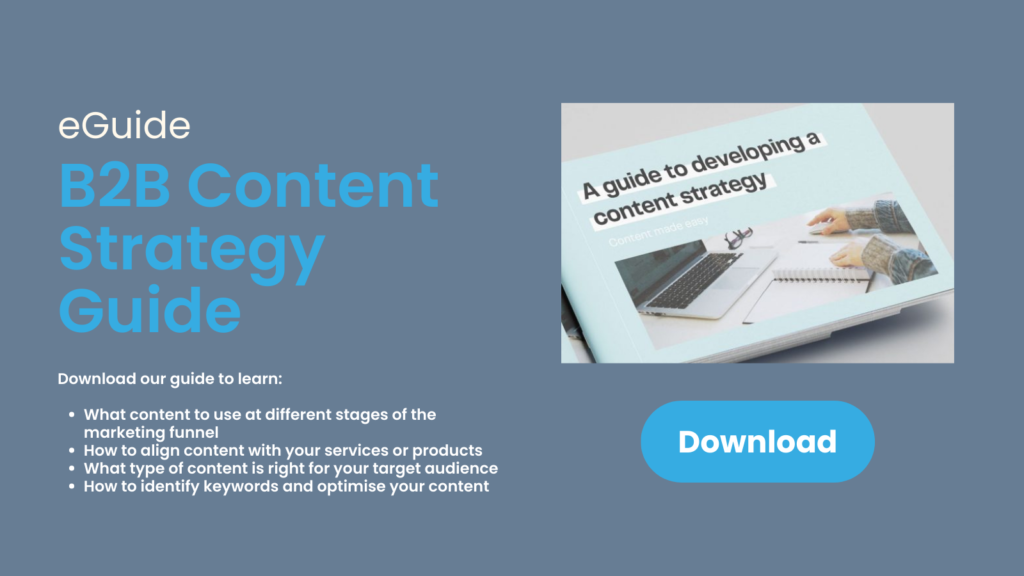Marketing personalisation goes beyond using someone’s first name in an email subject line. Or knowing when to trigger a marketing campaign because a contract is up for renewal, or a product they’ve bought is ready for an upgrade.
Most marketing personalisation activities kick in once someone is known to your business. They’re either a customer, an opportunity that you lost, or a prospect or lead that you have some data on.
But even before you know who you’re talking to there’s an opportunity to personalise content. You might not know their name so forget about {{name}} personalisation, but you still know plenty about them.
What do you know about your prospects?
An effective content marketing strategy puts your target audience at the heart of everything you do. You don’t need to know someone’s name in order to personalise their content journey.
Instead what you need is a detailed buyer persona based on someone you do know.
Take the example of a customer whose contract is up for renewal. You know loads about them. Their name, the company they work for, their industry, job title, how they found your business, their reasons for working with you etc. etc.
And what about the opportunity you lost? If you’ve got the data you should know who they are, the reasons they decided to sign up with a competitor, and – with hindsight – what might have helped your business close the deal.
Everything you know about an existing customer or lost opportunity can help you personalise content for prospects too.
Here’s another example for my marketing friends in recruitment:
You’ve got on-going demand for cybersecurity candidates and not enough registered with your agency. However, you’ve placed some great candidates and know plenty about them: such as what motivated them to explore other jobs and what differentiated the job they accepted from other opportunities.
Everything you know about successful candidates can help you personalise your content to attract more candidates like them.
Generic content doesn’t convert
To deliver a personalised content experience, avoid generic content at all costs! Yes, it will mean creating more content for different audiences, but that content is much more effective than a one-size-fits-all content experience.
By starting with an ideal customer (or candidate if you’re in recruitment) who you actually know, you can create a strong buyer persona and content that will attract and convert people like them.
Analyse how they engaged with your business and what content helped them through your marketing funnel. Track their journey via your CRM or if you don’t have the data, ask them.
Explore the following:
- How they found you: keyword search, social media, referral, email marketing etc.
- Preferred platforms and devices: if you know most of your customers start a search on a mobile device, design your content to be mobile friendly. Similarly, if the majority of customers come via LinkedIn, invest more resources in reaching prospects on this platform.
- What content they engaged with: blog posts, website pages, landing pages, PDFs, video content, infographics and so on.
- Conversion tools: chatbots, forms, surveys, lead generation tools – how did the customer first make themselves known to your business?
- Requested content: did they specifically ask for more information, such as case studies, testimonials, explainer videos, demos, sample reports, or on boarding information?
- Feedback: speak to other people in the business who know the customer to identify any other content that they have shared in order to close the deal, or would have found useful if it had been available.
How to personalise content when you don’t know someone’s name
Now that you have a list of content you need to create for your buyer persona, it’s time to start building your assets.
While you may not know your target audiences’ name, you can reference things you do know in order to personalise the content journey. You can do this in the following ways:
Demographics and firmographics
Use jobs titles and seniority, industry, company size (reference micro, SMB, enterprise or be more specific) and geographic location to personalise your content.
Personas
In some scenarios it may be appropriate to reference even more specific attributes in your content, such as referencing their age group or interests. If you have a very niche audience, e.g. cyber security professionals that snowboard, your content should reflect this!
Buyer journey
Show awareness of where your target audience is on their buyer journey and what they want to know at each stage.
Tone of voice
Speak to your audience in a natural human way. You may not know their name but simply using the word ‘you’ goes some way to personalising your content and making it all about them.
No shortcuts, well maybe some
Personalising content by buyer persona and demographics naturally means that some of your customers or prospects won’t engage with it because it’s not for them. It means you’ll need to create content specifically for those audiences and that means creating more content.
There are no shortcuts if you want to truly engage your audience and create content for them that builds trust and converts. However, there are often opportunities to repurpose more generic content for different audiences.
This could involve rewriting a blog post to make it more relevant. For example, take an article on finding your dream job and repurpose it as a blog post on finding your dream job in IT, or civil engineering, or hospitality – whatever vertical you need to target.
Using the contract renewal example from earlier in this article, write content about what to consider when a service contract is up for renewal. Write different versions for different job roles such as for the IT Manager, the Finance Director or the Procurement Officer – depending on who within an organisation is instrumental in the service provider decision-making process.
Take time to personalise each version for your different audiences using the information you know about them from your buyer persona. This way your content has the best chance of engaging them and showing you really understand them and their requirements.
So you see, personalisation starts before you even know someone’s name. And once you do know more about them, you’ll be able to personalise the content journey even further!





